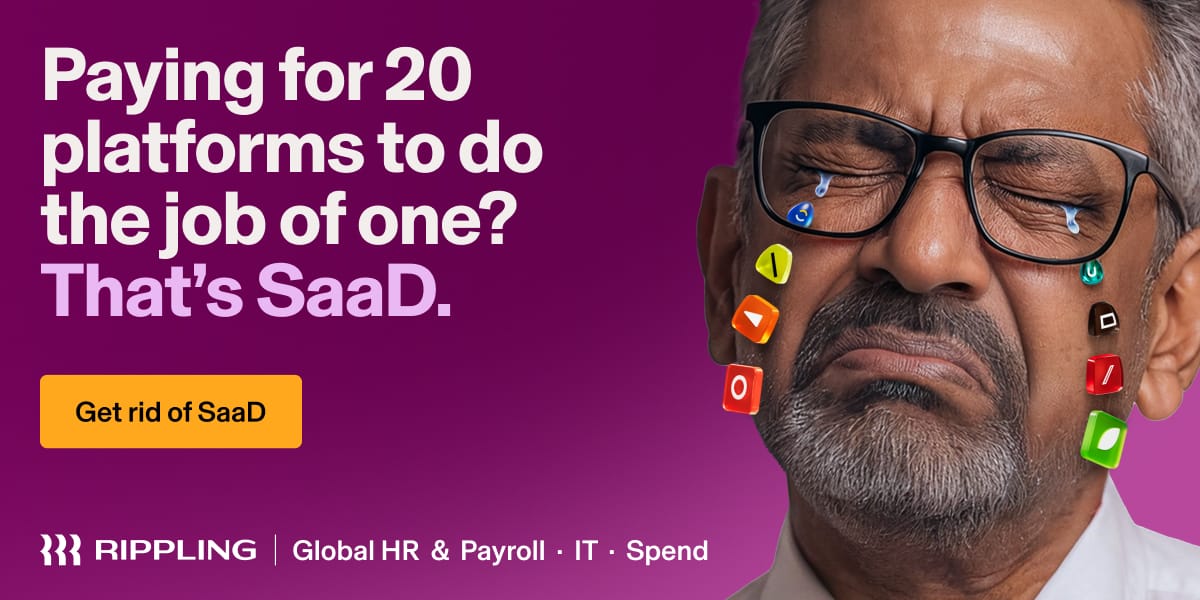Don’t get SaaD. Get Rippling.
Remember when software made business simpler?
Today, the average company runs 100+ apps—each with its own logins, data, and headaches. HR can’t find employee info. IT fights security blind spots. Finance reconciles numbers instead of planning growth.
Our State of Software Sprawl report reveals the true cost of “Software as a Disservice” (SaaD)—and how much time, money, and sanity it’s draining from your teams.
The future of work is unified. Don’t get SaaD. Get Rippling.
The Great AI Divide: A $1B Band-Aid on a Trillion-Dollar Problem
Listen, the DOE just dropped $1 billion on two AMD-powered supercomputers—Lux and Discovery—to tackle fusion energy, cancer research, and national security. Energy Secretary Chris Wright says they'll "recreate the center of the sun on Earth" and turn deadly cancers into manageable conditions within years. Sounds incredible, right?
Here's the kicker: this is exactly the problem.
The Productivity Chasm
Since ChatGPT launched in late 2022, S&P 500 companies have seen productivity surge 5.5%. Small businesses? They've fallen 12.3%. That's a 17.8 percentage point gap in under three years. The Big Four—Amazon, Alphabet, Microsoft, Meta—are dropping $364 billion on AI infrastructure this year alone. Amazon's automation plans will eliminate 160,000 future jobs by 2027, saving them $2-4 billion annually.
Meanwhile, 95% of AI projects at small businesses fail before producing value. Most SME leaders can't even figure out what AI does for their specific business. We're watching a K-shaped economy crystallize in real-time: the top 10% now account for 50% of consumer spending while entry-level job postings have crashed 35% since early 2023.
The Government Response
So what's Uncle Sam doing about this? Building two supercomputers for elite research labs.
Don't get me wrong—fusion energy and cancer cures are worthy goals. But here's what this partnership really represents: more concentration at the top. AMD gets validated as a player alongside Nvidia. Oak Ridge National Laboratory gets three times its current AI capacity. Big Tech gets another government-backed showcase for massive capital deployment.
Small businesses get... nothing.
The thing is, DOE's reasoning accidentally reveals the whole game. Wright said "AI is moving fast. If we move at the old speed of government, we're going to get left behind." Translation: We're in an arms race, and only entities with nine-figure budgets can play.
What This Actually Means
The Lux supercomputer goes live in six months—the fastest deployment AMD's CEO has ever seen. Discovery arrives in 2028 as a next-gen exascale beast. Both will accelerate research in energy, medicine, and defense. Wright says there will be "dozens" more partnerships like this.
But who's building the AI infrastructure for the pizza shop trying to optimize inventory? The accounting firm drowning in compliance work? The regional manufacturer competing with automated giants?
Nobody. Because there's no $1 billion public-private partnership for them.
The Paradox
McKinsey calls it the "gen AI paradox"—80% of businesses use generative AI, yet 80% report no bottom-line impact. Meanwhile, Microsoft is saving $500 million in call centers alone. Walmart's CEO says AI will "change literally every job" for their 2.1 million workers. Amazon plans to automate 75% of operations.
The gap isn't just widening—it's becoming structural. We're not talking about a temporary advantage. We're watching the permanent stratification of the American economy, where computational power determines your competitive position and only the biggest players can afford admission.
Wright wants to win the "AI race." Fair enough. But maybe ask: who's actually racing, and who's just getting run over?
The DOE-AMD partnership launches in 2026. The small business failures are already here.

